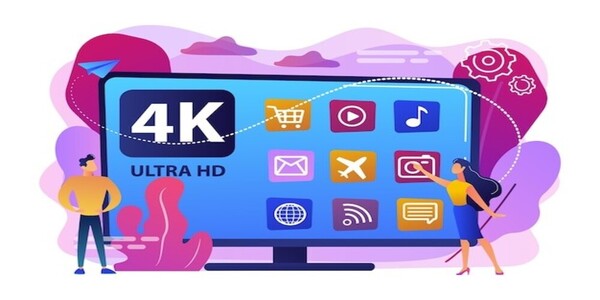
As technology evolves, so too does the way we experience entertainment. OTT (over-the-top) services have revolutionized the entertainment industry, offering an easily accessible and cost-effective alternative to traditional streaming platforms like Hulu and Netflix. A wide range of consumers are discovering that they no longer need to be tethered to their living rooms in order to watch content; instead, they can connect their device through virtually any internet connection or wireless network around the world and enjoy movies, television shows, sports media, and more on-demand when it suits them best.
Exploring the Rise of OTT – What is it, and what has changed in the entertainment industry

OTT stands for “over-the-top” and refers to delivering video content over the internet, bypassing traditional cable or satellite TV providers. Over The Top services allow users to watch their favorite movies, TV shows, and other forms of video content on-demand, at their convenience.
OTT has changed the entertainment industry in several ways:
Disrupting the traditional distribution model: Over the top platforms have disrupted the traditional distribution model, which relied on cable or satellite TV providers to deliver content to consumers. With this, viewers can bypass cable or satellite providers and directly access content via the internet, creating a more democratized market.
Changing consumer viewing habits: The rise of over the top has also changed consumer viewing habits, with viewers now able to watch content on-demand, at their convenience, and on a range of devices, including smartphones, tablets, and smart TVs. This has created a more personalized and flexible viewing experience, which consumers have increasingly embraced.
Increasing competition: The rise of over the top has also increased competition in the entertainment industry. Traditional media companies are now competing with OTT providers such as Netflix, Amazon Prime Video, and Hulu, which are producing original content to attract viewers.
Redefining monetization models: OTT has also redefined the monetization models in the entertainment industry. Traditional cable and satellite TV providers paid content creators for their content based on advertising revenue or licensing fees. With over the top, providers can monetize content through subscription fees, advertising, and a range of other models.
Overall, the rise of OTT has transformed the entertainment industry, creating new opportunities for content creators and changing the way viewers consume content.
Advantages of OTT – Easier Accessibility and Lower Cost for Users

Yes, OTT has several advantages, including easier accessibility and lower cost for users.
Easier Accessibility: OTT services make it easier for users to access their favorite content from anywhere, at any time. Users can watch content on their smartphones, tablets, laptops, or smart TVs, making it convenient for them to access content on-the-go or from the comfort of their own homes. This accessibility is especially beneficial for users who live in areas with limited access to traditional cable or satellite TV services.
Lower Cost: Many OTT services are priced lower than traditional cable or satellite TV services, making them more affordable for users. With the ability to choose from different subscription models, users can select the one that best fits their needs and budget. Additionally, many over the top services offer free trials, allowing users to test the service before committing to a subscription.
Personalized Content: OTT services often offer personalized recommendations based on a user’s viewing history and preferences, providing a more tailored viewing experience. This personalized content can help users discover new shows and movies that they might not have otherwise found.
Original Content: Many OTT services produce their own original content, which is not available on traditional cable or satellite TV services. This original content can be of high quality and attract users looking for new and unique content.
Overall, the advantages of over the top services make them an attractive option for users who are looking for affordable, personalized, and convenient access to their favorite content.
Disadvantages of OTT – Potential Problems with Quality Control and Legal Issues

While OTT services offer several advantages, there are also some potential disadvantages, including problems with quality control and legal issues.
Quality Control: Since OTT services are delivered over the internet, the quality of the video stream can be affected by factors such as internet speed and bandwidth. This can result in buffering, poor picture quality, and other technical issues that can impact the user’s viewing experience. Additionally, since OTT services often rely on third-party content providers, there can be issues with content quality and consistency.
Legal Issues: Since OTT services offer a wide range of content, including movies and TV shows, there can be legal issues related to copyright infringement and piracy. over the top service providers need to ensure that they have the necessary licenses and permissions to distribute content and take steps to prevent illegal distribution of copyrighted material. Failure to do so can result in legal and financial penalties.
Limited Availability: While OTT services are becoming more widely available, they may not be available in all regions or countries. This can limit the availability of certain content and can be frustrating for users who are unable to access their favorite shows and movies.
Technical Challenges: Since OTT services rely on internet connectivity, they can be subject to technical challenges related to connectivity, device compatibility, and user experience. These challenges can impact the user’s ability to access and enjoy content, and can result in frustration and dissatisfaction.
Overall, while OTT services offer many benefits, there are also potential drawbacks related to quality control, legal issues, limited availability, and technical challenges. It is important for users to consider these factors when choosing an OTT service, and for providers to address these issues to ensure a positive user experience.
The Impact on Traditional Media Industry – How will it Change the Way We Consume Entertainment

The rise of OTT has had a significant impact on the traditional media industry and is changing the way we consume entertainment in several ways:
Shift in Power: The traditional media industry has historically been dominated by a few large corporations, who controlled the production, distribution, and monetization of content. With the rise of OTT, the power has shifted to the consumers, who now have more control over what they watch, how they watch it, and how they pay for it.
Increased Competition: OTT providers have increased competition in the entertainment industry, with traditional media companies now competing with these new players for viewers and subscribers. This has forced traditional media companies to adapt and innovate, and has led to increased investment in original content and other strategies to retain viewers.
Disruptive Business Models: The business models used by OTT providers are disrupting the traditional models used by the media industry. For example, instead of relying on advertising revenue or licensing fees, OTT providers generate revenue through subscriptions, pay-per-view models, and other innovative approaches.
Greater Personalization: OTT services offer greater personalization than traditional media, as viewers can choose what they want to watch and when they want to watch it. This has led to a shift away from scheduled programming, resulting in a more on-demand viewing experience.
Global Reach: OTT services have a global reach, which has expanded the content creator market and led to more diverse and varied content being produced. This has also led to an increase in cross-cultural exchange and a more globalized entertainment industry.
Overall, the rise of OTT is changing the way we consume entertainment, with increased competition, disruptive business models, and greater personalization.
How Streaming Services are Adapting to the Trend – Strategies to Tap into Audience Engagement

Streaming services are adapting to the trend of OTT by implementing various strategies to tap into audience engagement. Here are some ways streaming services are adapting:
Original Content: Many streaming services are investing in producing original content, which sets them apart from traditional media and gives them a competitive edge. This strategy helps build brand identity, attracts viewers, and keeps them engaged with new and exclusive content.
Personalization: Streaming services are leveraging user data to provide personalized recommendations and a more customized viewing experience. Streaming services can offer content tailored to each individual’s tastes and interests by collecting data on users’ viewing habits and preferences.
Flexibility and Convenience: Streaming services offer a more flexible and convenient viewing experience than traditional media, as viewers can watch content on their own schedule, on any device. Streaming services also offer options to download content for offline viewing, which is especially useful for users with limited or unreliable internet access.
Multiple Pricing Models: Streaming services offer multiple pricing models, including monthly and annual subscriptions, pay-per-view, and ad-supported options. This allows users to choose the best pricing model for their budget and viewing preferences.
Social Media Engagement: Streaming services are leveraging social media platforms to engage with viewers, promote new releases, and encourage user-generated content. This approach helps build a community around the service, which can foster a sense of loyalty among users.
Partnerships and Bundling: Streaming services are forming partnerships and bundling options with other services to provide a more comprehensive offering to users. For example, some streaming services have partnered with internet service providers or mobile carriers to offer bundled subscriptions or discounts.
Case Study – Analyzing an OTT Success Story and Assessing its Long-term Market Potential

One successful OTT platform that can be analyzed as a case study is Netflix. Netflix has been a pioneer in the OTT industry and has been able to grow and adapt to changes in the industry. Here’s an analysis of Netflix and its long-term market potential:
Business Model: Netflix started as a DVD-by-mail rental service but quickly pivoted to an OTT model. It has since expanded into producing original content, which has helped it differentiate itself from competitors. Netflix generates revenue through subscriptions, which is a sustainable and predictable revenue stream.
Content: Netflix has a vast library of content, including licensed content from other networks and studios and original content. Its original content has been well-received by critics and audiences alike, and has won numerous awards.
Personalization: Netflix’s sophisticated recommendation engine uses user data to suggest content to viewers. This personalized viewing experience has helped Netflix build a loyal user base, as users feel like the service is tailored to their interests.
Global Reach: Netflix is available in over 190 countries, which has expanded its market potential and created opportunities for growth. Its global reach has allowed it to invest in content that appeals to a global audience and has helped it stay ahead of the competition.
Competition: The OTT industry is highly competitive, with new players entering the market every year. However, Netflix has been able to maintain its position as a market leader by continuously innovating and investing in content and technology.
In terms of long-term market potential, Netflix has several advantages that position it for continued growth. Its business model is sustainable and predictable, and its investment in original content has helped it differentiate itself from competitors.
In Conclusion
With the rise of OTT, we have seen an exponential growth in audience engagement and a noticeable shift in the way we consume entertainment. It’s true that this new technology brings about a variety of advantages as well as some potential problems — but overall, it has created an opportunity for industry innovators to expand their existing services to tap into the ever-growing OTT market. From lower costs to easier accessibilities, there is much excitement surrounding all of the possibilities coming from streaming services. But with so much competition on the horizon, it will be interesting to watch how these services navigate their strategie s in order to adapt and remain successful over time


